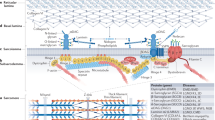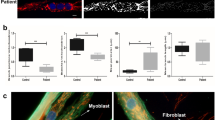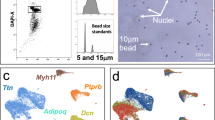Abstract
Duchenne muscular dystrophy (DMD) is a human X-linked biochemical defect resulting in the progressive wasting of skeletal muscle of affected individuals1. It is the most common and is considered to be the most devastating of the muscular dystrophies, affecting about 1 in 3,500 live-born males2. The gene that, when defective, results in this disorder was recently isolated3–6. Using the cloned complementary DNA sequences corresponding to the DMD gene, antibodies have been produced that react with a protein species of relative molecular mass (Mr) ∼400,000 (400K) which was absent in two DMD-affected individuals and in mdx mice7. This protein species is called dystrophin because of its identification by molecular-genetic analysis of affected individuals. Here we show that dystrophin is associated with the triadic junctions in skeletal muscle, and is therefore probably involved with Ca2+ homoeostasis. We also show that the ∼450K ryanodine receptor/sarcoplasmic reticulum Ca2+ channel8, which has the large size and subcellular distribution characteristics of dystrophin, is an immunologically distinct protein species.
This is a preview of subscription content, access via your institution
Access options
Subscribe to this journal
Receive 51 print issues and online access
$199.00 per year
only $3.90 per issue
Buy this article
- Purchase on Springer Link
- Instant access to full article PDF
Prices may be subject to local taxes which are calculated during checkout
Similar content being viewed by others
References
1. Walton, J. N. & Gardner-Medwin, D. in Disorders of Voluntary Muscle (ed. Walton, S. J.) 481-524 (Churchill Livingstone, Edinburgh, 1981). 2. Moser, H. Hum. Genet. 66, 17-40 (1984). 3. Monaco, A. P. et al. Nature 323, 646-650 (1986). 4. Koenig, M. et al. Cell 50, 509-517 (1987). 5. Hoffman, E. P., Monaco, A. P., Feener, C. C. & Kunkel, L. M. Science 238, 347-350 (1987). 6. Burghes, A. H. et al. Nature 328, 434-437 (1987). 7. Hoffman, E. P., Brown, R. H. & Kunkel, L. M. Cell (in the press). 8. Imagawa, T., Smith, J. S., Coronado, R. & Campbell, K. P. J. biol. Chem. 262, 16636-16643 (1987). 9. Lev, A., Feener, C., Kunkel, L. M. & Brown, R. H. J. biol. Chem. (in the press). 10. Hammonds, R. G. Cell 51, 1 (1987). 11. Mitchell, R. D., Palade, P. & Fleischer, S. /. Cell Biol. 96, 1008-1016 (1983). 12. Mrak, R. E. & Fleischer, S. Muscle Nerve 5, 143-151 (1982). 13. Kaprielian, Z. & Fambrough, D. M. Devl Biol. (in the press). 14. Campbell, K. P. et al. J. biol. Chem. 262, 6460-6463 (1987). 15. Stone, D. & Smillie, L. B. J. biol. Chem. 253, 1137-1148 (1978). 16. Campbell, K. P., Franzini-Armstrong, C. & Shamoo, A. E. Biochim. biophys. Acta 602, 97-116 (1980). 17. Leung, A. T., Imagawa, T. & Campbell, K. P. /. biol. Chem. 253, 1137-1148 (1978). 18. Sharp, A. H., Imagawa, T., Leung, A. T. & Campbell, K. P. /. biol. Chem. 262, 12309-12315 (1987). 19. Bios, E. & Brum, G. Nature 325, 717-720 (1987). 20. Tanabe, T. et al. Nature 328, 313-318 (1987). 21. Leung, A. T., Imagawa, T., Block, B., Franzini-Armstrong, C. & Campbell, K. P. J. biol.Chem. (in the press). 22. Smith, J. S., Coronado, R. & Meissner, G. Nature 316, 446-449 (1985). 23. Jackson, M. J., Jones, D. A. & Edwards, R. H. Eur. J. din. Invest. 13, 369-374 (1984). 24. Noegel, A., Witke, W. & Schleicher, M. Fedn Eur. Biochem. Sci. 221, 391-396 (1987). 25. Watkins, S. C. & Cullen, M. J. /. neurol. Sci. (in the press). 26. Oguchi, K., Yanagisawa, N. & Tsukagoshi, H. J. neurol. Sci. 57, 333-341 (1982). 27. Rodemann, H. P., Waxman, L. & Goldberg, A. L. J. biol. Chem. 257, 8716-8723 (1982). 28. Martonosi, A. N. in Myology (eds Engel, A. G. & Banker, B. Q.) 521-562 (McGraw Hill, New York, 1986). 29. Tung, A. S. Meth. Enzym. 93, 12-23 (1983). 30. Laemmli, U. K. Nature 227, 680-685 (1970). 31. Wang, K. Cell Muscle Motil. 6, 314-369 (1985). 32. Sugita, H. et al Proc. Jap. Acad. 63, 107-110 (1987). 33. Peterson, G. L. Analyt. Biochem. 83, 346-356 (1977).
Author information
Authors and Affiliations
Rights and permissions
About this article
Cite this article
Hoffman, E., Knudson, C., Campbell, K. et al. Subcellular fractionation of dystrophin to the triads of skeletal muscle. Nature 330, 754–758 (1987). https://doi.org/10.1038/330754a0
Received:
Accepted:
Issue Date:
DOI: https://doi.org/10.1038/330754a0
This article is cited by
-
An overview of recent US-approved gene therapies for Duchenne muscular dystrophy and their respective clinical development programs
Drugs & Therapy Perspectives (2023)
-
Integrative effects of dystrophin loss on metabolic function of the mdx mouse
Scientific Reports (2018)
-
Development Aspects of Zebrafish Myotendinous Junction: a Model System for Understanding Muscle Basement Membrane Formation and Failure
Current Pathobiology Reports (2017)
-
Early pathogenesis of Duchenne muscular dystrophy modelled in patient-derived human induced pluripotent stem cells
Scientific Reports (2015)
-
Genetic evidence in the mouse solidifies the calcium hypothesis of myofiber death in muscular dystrophy
Cell Death & Differentiation (2015)
Comments
By submitting a comment you agree to abide by our Terms and Community Guidelines. If you find something abusive or that does not comply with our terms or guidelines please flag it as inappropriate.



